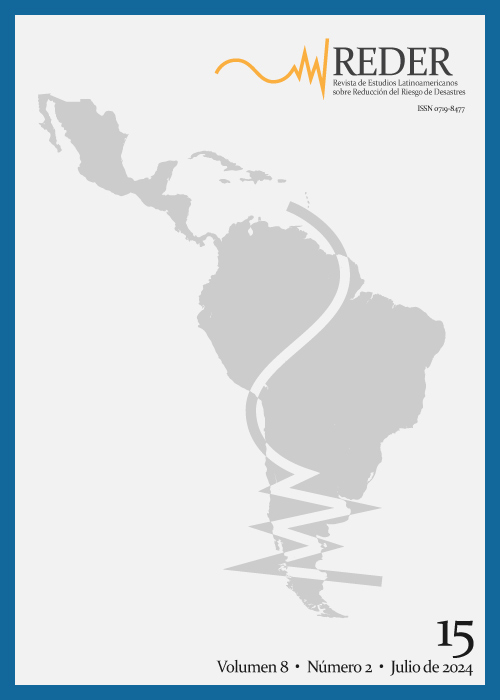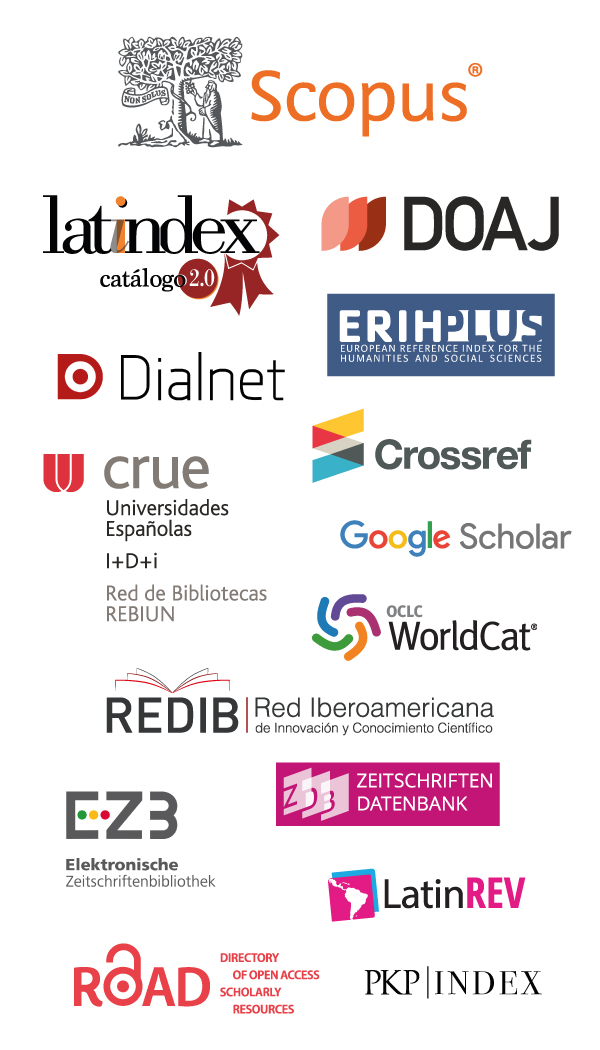Soluciones alimentarias resilientes para evitar la hambruna masiva durante un invierno nuclear en Argentina
DOI: https://doi.org/10.55467/reder.v8i2.164
Resumen
Una guerra nuclear, una erupción volcánica, o el impacto de un asteroide o cometa pueden reducir la cantidad de luz solar que alcanza la superficie terrestre, de la que depende el sistema alimentario global. Los rendimientos agrícolas caerían debido a la disminución de temperaturas y precipitaciones, lo que se define como un Escenario de Reducción Abrupta de la Luz Solar (ERALS). Argentina podría tener un papel clave en caso de que esto ocurriese. Aquí se se modelizan las intervenciones que permitirían prevenir la hambruna en Argentina e incluso en toda América Latina, incluyendo: redirección de alimentos usados como materias primas en la ganadería y producción de biocombustibles, racionamiento, relocalización de cultivos, despliegue de invernaderos simples y cultivo de algas, entre otras. Si no se implementasen adaptaciones adecuadas, la producción bruta podría caer al 30% del nivel actual, resultando insuficiente para la población Argentina. Afortunadamente, los resultados indican que incluso en un escenario de 150 Tg, las adaptaciones permitirían aumentar la producción neta desde una situación de hambruna nacional (1500 kcal/día/persona) hasta una producción equivalente a entre 3 y 6 veces la cantidad necesaria para la población Argentina (7800 - 14000 kcal/día/persona).
Palabras clave
Texto completo:
PDFReferencias
ALLFED, 2022. A Strategic Proposal to Facilitate U.S. Food Security in an Abrupt Sunlight Reduction Scenario (Unpublished).
Alvarado, K.A., Mill, A., Pearce, J.M., Vocaet, A., Denkenberger, D., 2020. Scaling of greenhouse crop production in low sunlight scenarios. Sci. Total Environ. 707, 136012. https://doi.org/10.1016/j.scitotenv.2019.136012
Bailey, R., Benton, T., Challinor, A., Elliott, J., Gustafson, D., Hiller, B., Jones, A., Kent, A., Lewis, K., Meacham, T., 2015. Extreme weather and resilience of the global food system: Final project report from the UK-US taskforce on extreme weather and global food system resilience. The Global Food Security Programme, London.
Barrett, A.M., Baum, S.D., Hostetler, K., 2013. Analyzing and Reducing the Risks of Inadvertent Nuclear War Between the United States and Russia. Sci. Glob. Secur.
Baum, S., Denkenberger, D.C., Pearce, J.M., Robock, A., Winkler, R., 2015. Resilience to Global Food Supply Catastrophes. Environ Syst Decis, 35, 301–313. https://doi.org/10.1007/s10669-015-9549-2
Benedict, K., Kane, A., Castro, J., Osano, P., Heymann, D., Kofler, R., Johnson, L., Drolshagen, G., 2021. Global Catastrophic Risks 2021: Navigating the Complex Intersections. Global Challenges Foundation.
Bostrom, N., Cirkovic, M.M., 2008. Global Catastrophic Risks. Oxford University Press.
Boyd, M., Wilson, N., 2022. Island refuges for surviving nuclear winter and other abrupt sunlight-reducing catastrophes. Risk Analysis, 43, 1824–1842. https://doi.org/10.1111/risa.14072
CEP XXI, MAGyPN, 2020. Informe de Coyuntura Agrícola. Gobierno de Argentina.
Coupe, J., Bardeen, C.G., Robock, A., Toon, O.B., 2019. Nuclear Winter Responses to Nuclear War Between the United States and Russia in the Whole Atmosphere Community Climate Model Version 4 and the Goddard Institute for Space Studies ModelE. J. Geophys. Res. Atmospheres, 124, 8522–8543. https://doi.org/10.1029/2019JD030509
Crutzen, P., Birks, J., 1983. The Atmosphere after a Nuclear War: Twilight at Noon. IAEA.
Denkenberger, D., Pearce, J., 2017. Cost-effectiveness of interventions for alternate food in the United States to address agricultural catastrophes. Int. J. Disaster Risk Reduct., 27, 278–289. https://doi.org/10.1016/j.ijdrr.2017.10.014
Denkenberger, D.C., Pearce, J.M., 2014. Feeding Everyone: Solving the Food Crisis in Event of Global Catastrophes that Kill Crops or Obscure the Sun 18. Futures, 72, 57-68, http://dx.doi.org/10.2139/ssrn.3331187
García Martínez, J.B., Alvarado, K.A., Denkenberger, D.C., 2022a. Synthetic fat from petroleum as a resilient food for global catastrophes: Preliminary techno-economic assessment and technology roadmap. Chem. Eng. Res. Des., 177, 255–272. https://doi.org/10.1016/j.cherd.2021.10.017
García Martínez, J.B., Pearce, J.M., Throup, J., Cates, J., Lackner, M., Denkenberger, D.C., 2022b. Methane Single Cell Protein: Potential to Secure a Global Protein Supply Against Catastrophic Food Shocks. Front. Bioeng. Biotechnol. 10.
García Martínez, J.B., Egbejimba, J., Throup, J., Matassa, S., Pearce, J.M., Denkenberger, D.C., 2021. Potential of microbial protein from hydrogen for preventing mass starvation in catastrophic scenarios. Sustain. Prod. Consum., 25, 234–247. https://doi.org/10.1016/j.spc.2020.08.011
Jehn, F.U., Dingal, F.J., Mill, A., Harrison, C.S., Ilin, E., Roleda, M.Y., James, S.C., Denkenberger, D.C., 2023. Seaweed as a resilient food solution after a nuclear war. Zenodo. https://doi.org/10.5281/ZENODO.7578762
Lin, J., Svensson, A., Hvidberg, C.S., Lohmann, J., Kristiansen, S., Dahl-Jensen, D., Steffensen, J.P., Rasmussen, S.O., Cook, E., Kjær, H.A., Vinther, B.M., Fischer, H., Stocker, T., Sigl, M., Bigler, M., Severi, M., Traversi, R., Mulvaney, R., 2022. Magnitude, frequency and climate forcing of global volcanism during the last glacial period as seen in Greenland and Antarctic ice cores (60–9 ka). Clim Past, 18, 485–506. https://doi.org/10.5194/cp-18-485-2022
Martin, B., 1988. Nuclear winter: science and politics. Sci. Public Policy, 15, 321–334. https://doi.org/10.1093/spp/15.5.321
Maynard, T, 2015. Food system shock: the insurance impacts of acute disruption to global food supply. Lloyd’s Emerg. Risk Rep. Lloyd’s Lond. UK.
Pham, A., García Martínez, J.B., Brynych, V., Stormbjorne, R., Pearce, J.M., Denkenberger, D.C., 2022. Nutrition in Abrupt Sunlight Reduction Scenarios: Envisioning Feasible Balanced Diets on Resilient Foods. Nutrients, 14, 492. https://doi.org/10.3390/nu14030492
Portman, R., 2023. S.4488 - Global Catastrophic Risk Management Act of 2022.
Raffo, M.P., Dellatorre, F., Ciancia, M., 2022. Seaweed resources of Argentina (S W Atlantic): production, bio-ecological, applied research and challenges for sustainable development. Appl. Phycol., 3, 383–421. https://doi.org/10.1080/26388081.2022.2076260
Ritchie, H., Roser, M., 2013. Land Use. Our World Data.
Rivers, M., García Martínez, J., Tieman, R., Jaeck, V., Butt, T., Denkenberger, D., 2022a. Deployment of Resilient Foods Can Greatly Reduce Famine in an Abrupt Sunlight Reduction Scenario. [Preprint] https://doi.org/10.21203/rs.3.rs-1446444/v1
Rivers, M., Hinge, M., García Martínez, J.B., Tieman, R., Jaeck, V., Butt, T., Jehn, F., Grillo, V., Denkenberger, D., 2022b. Food System Adaptation and Maintaining Trade Greatly Mitigate Global Famine in Abrupt Sunlight Reduction Scenarios. [Preprint] https://allfed.info/images/pdfs/Preprint%20V2.0%20Integrated%20assessment%20ALLFED.docx.pdf
Rivers, M., Jehn, F.U., Lint Action, K-R-A-S-S, LzhangUT, Strange-Boop, Mears, D., Jaz H, 2023. allfed/allfed-integrated-model: Argentina. [Preprint] https://doi.org/10.5281/ZENODO.8253820
Robock, A., 2015. Climate and Climate Change | Nuclear Winter. En: North, G.R., Pyle, J., Zhang, F. (Eds.), Encyclopedia of Atmospheric Sciences (Second Edition). Academic Press, Oxford, pp. 95–101. https://doi.org/10.1016/B978-0-12-382225-3.00245-0
Sandoval, V., Voss, M., Flörchinger, V., Lorenz, S. & Jafari, P., 2023. Integrated Disaster Risk Management (IDRM): Elements to Advance its Study and Assessment. International Journal of Disaster Risk Science, 14(3), 343–356. https://doi.org/10.1007/s13753-023-00490-1
SINAGIR, 2018. Plan Nacional para la Reducción del Riesgo de Desastres 2018-2023. Sistema Nacional para la Gestión Integral del Riesgo.
Symons, G.J., 1888. The eruption of Krakatoa, and subsequent phenomena: report of the Krakatoa Committee of the Royal Society. No Title.
Throup, J., García Martínez, J.B., Bals, B., Cates, J., Pearce, J.M., Denkenberger, D.C., 2022. Rapid repurposing of pulp and paper mills, biorefineries, and breweries for lignocellulosic sugar production in global food catastrophes. Food Bioprod. Process., 131, 22–39. https://doi.org/10.1016/j.fbp.2021.10.012
Torres, J., Roberto, T., Daniela, T., Monica, U., Jaime, S., Juan, G., 2023a. Apéndices informe “Propuesta estratégica para facilitar la seguridad alimentaria de argentina en un escenario de reducción abrupta de la luz solar”. https://doi.org/10.5281/zenodo.7863880
Torres, J., Ulloa, M., Tiznado, D., Tinoco, R., Bas, G.B., Sevilla, J., Garcia, J., Morgan, R., Denkenberger, D., 2023b. Seguridad alimentaria en Argentina en caso de un Escenario de Reducción Abrupta de la Luz Solar (ERALS) Propuesta Estratégica. https://doi.org/10.13140/RG.2.2.11906.96969
Turco, R.P., Toon, O.B., Ackerman, T.P., Pollack, J.B., Sagan, C., 1983. Nuclear Winter: Global Consequences of Multiple Nuclear Explosions. Science, 222, 1283–1292. https://doi.org/10.1126/science.222.4630.1283
Tzachor, A., Richards, C.E., Holt, L., 2021. Future foods for risk-resilient diets. Nat. Food, 2, 326–329. https://doi.org/10.1038/s43016-021-00269-x
United Nations, 2023. Our Common Agenda Policy Brief 2: Strengthening the International Response to Complex Global Shocks – An Emergency Platform (Policy Brief). United Nations.
Wilson, N., Valler, V., Cassidy, M., Boyd, M., Mani, L., Brönnimann, S., 2023. Impact of the Tambora volcanic eruption of 1815 on islands and relevance to future sunlight-blocking catastrophes. Sci. Rep., 13, 3649. https://doi.org/10.1038/s41598-023-30729-2
World Bank, 2021. Worldwide Governance Indicators (WGI). The World Bank.
World Economic Forum, 2020. Global Competitiveness Report Special Edition 2020: How Countries are Performing on the Road to Recovery. WEF.
Xia, L., Robock, A., Scherrer, K., Harrison, C.S., Bodirsky, B.L., Weindl, I., Jägermeyr, J., Bardeen, C.G., Toon, O.B., Heneghan, R., 2022. Global food insecurity and famine from red uced crop, marine fishery and livestock production due to climate disruption from nuclear war soot injection. Nat. Food, 3, 586–596. https://doi.org/10.1038/s43016-022-00573-0
Enlaces refback
- No hay ningún enlace refback.








